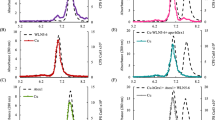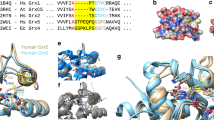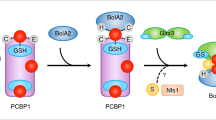Abstract
In eukaryotes, cytosolic monothiol glutaredoxins are proteins implicated in intracellular iron trafficking and sensing via their bound [2Fe-2S] clusters. We define a new role of human cytosolic monothiol glutaredoxin-3 (GRX3) in transferring its [2Fe-2S] clusters to human anamorsin, a physical and functional protein partner of GRX3 in the cytosol, whose [2Fe-2S] cluster–bound form is involved in the biogenesis of cytosolic and nuclear Fe-S proteins. Specific protein recognition between the N-terminal domains of the two proteins is the mandatory requisite to promote the [2Fe-2S] cluster transfer from GRX3 to anamorsin.
This is a preview of subscription content, access via your institution
Access options
Subscribe to this journal
Receive 12 print issues and online access
$259.00 per year
only $21.58 per issue
Buy this article
- Purchase on Springer Link
- Instant access to full article PDF
Prices may be subject to local taxes which are calculated during checkout





Similar content being viewed by others
Accession codes
References
Banci, L. et al. [2Fe-2S] cluster transfer in iron-sulfur protein biogenesis. Proc. Natl. Acad. Sci. USA 111, 6203–6208 (2014).
Haunhorst, P., Berndt, C., Eitner, S., Godoy, J.R. & Lillig, C.H. Characterization of the human monothiol glutaredoxin 3 (PICOT) as iron-sulfur protein. Biochem. Biophys. Res. Commun. 394, 372–376 (2010).
Lill, R. et al. The role of mitochondria in cellular iron-sulfur protein biogenesis and iron metabolism. Biochim. Biophys. Acta 1823, 1491–1508 (2012).
Uzarska, M.A., Dutkiewicz, R., Freibert, S.A., Lill, R. & Muhlenhoff, U. The mitochondrial Hsp70 chaperone Ssq1 facilitates Fe/S cluster transfer from Isu1 to Grx5 by complex formation. Mol. Biol. Cell 24, 1830–1841 (2013).
Mapolelo, D.T. et al. Monothiol glutaredoxins and A-type proteins: partners in Fe-S cluster trafficking. Dalton Trans. 42, 3107–3115 (2013).
Shakamuri, P., Zhang, B. & Johnson, M.K. Monothiol glutaredoxins function in storing and transporting [Fe2S2] clusters assembled on IscU scaffold proteins. J. Am. Chem. Soc. 134, 15213–15216 (2012).
Philpott, C.C. Coming into view: eukaryotic iron chaperones and intracellular iron delivery. J. Biol. Chem. 287, 13518–13523 (2012).
Mühlenhoff, U. et al. Cytosolic monothiol glutaredoxins function in intracellular iron sensing and trafficking via their bound iron-sulfur cluster. Cell Metab. 12, 373–385 (2010).
Haunhorst, P. et al. Crucial function of vertebrate glutaredoxin 3 (PICOT) in iron homeostasis and hemoglobin maturation. Mol. Biol. Cell 24, 1895–1903 (2013).
Poor, C.B. et al. Molecular mechanism and structure of the Saccharomyces cerevisiae iron regulator Aft2. Proc. Natl. Acad. Sci. USA 111, 4043–4048 (2014).
Yamaguchi-Iwai, Y., Stearman, R., Dancis, A. & Klausner, R.D. Iron-regulated DNA binding by the AFT1 protein controls the iron regulon in yeast. EMBO J. 15, 3377–3384 (1996).
Rutherford, J.C., Jaron, S., Ray, E., Brown, P.O. & Winge, D.R. A second iron-regulatory system in yeast independent of Aft1p. Proc. Natl. Acad. Sci. USA 98, 14322–14327 (2001).
Blaiseau, P.L., Lesuisse, E. & Camadro, J.M. Aft2p, a novel iron-regulated transcription activator that modulates, with Aft1p, intracellular iron use and resistance to oxidative stress in yeast. J. Biol. Chem. 276, 34221–34226 (2001).
Ojeda, L. et al. Role of glutaredoxin-3 and glutaredoxin-4 in the iron regulation of the Aft1 transcriptional activator in Saccharomyces cerevisiae. J. Biol. Chem. 281, 17661–17669 (2006).
Anderson, C.P., Shen, M., Eisenstein, R.S. & Leibold, E.A. Mammalian iron metabolism and its control by iron regulatory proteins. Biochim. Biophys. Acta 1823, 1468–1483 (2012).
Li, H. et al. The yeast iron regulatory proteins Grx3/4 and Fra2 form heterodimeric complexes containing a [2Fe-2S] cluster with cysteinyl and histidyl ligation. Biochemistry 48, 9569–9581 (2009).
Hoffmann, B. et al. The multidomain thioredoxin-monothiol glutaredoxins represent a distinct functional group. Antioxid. Redox Signal. 15, 19–30 (2011).
Li, H. & Outten, C.E. Monothiol CGFS glutaredoxins and BolA-like proteins: [2Fe-2S] binding partners in iron homeostasis. Biochemistry 51, 4377–4389 (2012).
Rual, J.F. et al. Towards a proteome-scale map of the human protein-protein interaction network. Nature 437, 1173–1178 (2005).
Banci, L. et al. Molecular view of an electron transfer process essential for iron-sulfur protein biogenesis. Proc. Natl. Acad. Sci. USA 110, 7136–7141 (2013).
Netz, D.J. et al. Tah18 transfers electrons to Dre2 in cytosolic iron-sulfur protein biogenesis. Nat. Chem. Biol. 6, 758–765 (2010).
Saito, Y. et al. PICOT is a molecule which binds to anamorsin. Biochem. Biophys. Res. Commun. 408, 329–333 (2011).
Shibayama, H. et al. Identification of a cytokine-induced antiapoptotic molecule anamorsin essential for definitive hematopoiesis. J. Exp. Med. 199, 581–592 (2004).
Tanimura, A. et al. The anti-apoptotic gene Anamorsin is essential for both autonomous and extrinsic regulation of murine fetal liver hematopoiesis. Exp. Hematol. 42, 410–422 (2014).
Cha, H. et al. PICOT is a critical regulator of cardiac hypertrophy and cardiomyocyte contractility. J. Mol. Cell. Cardiol. 45, 796–803 (2008).
Tarassov, K. et al. An in vivo map of the yeast protein interactome. Science 320, 1465–1470 (2008).
Banci, L. et al. Anamorsin is a [2Fe-2S] cluster–containing substrate of the Mia40-dependent mitochondrial protein-trapping machinery. Chem. Biol. 18, 794–804 (2011).
Li, H., Mapolelo, D.T., Randeniya, S., Johnson, M.K. & Outten, C.E. Human glutaredoxin 3 forms [2Fe-2S]-bridged complexes with human BolA2. Biochemistry 51, 1687–1696 (2012).
Banci, L. et al. Human anamorsin binds [2Fe-2S] clusters with unique electronic properties. J. Biol. Inorg. Chem. 18, 883–893 (2013).
Dominguez, C., Boelens, R. & Bonvin, A.M. HADDOCK: a protein-protein docking approach based on biochemical or biophysical information. J. Am. Chem. Soc. 125, 1731–1737 (2003).
Zuiderweg, E.R. Mapping protein-protein interactions in solution by NMR spectroscopy. Biochemistry 41, 1–7 (2002).
Ciofi-Baffoni, S., Gallo, A., Muzzioli, R. & Piccioli, M. The IR-15N-HSQC-AP experiment: a new tool for NMR spectroscopy of paramagnetic molecules. J. Biomol. NMR 58, 123–128 (2014).
Oldfield, C.J. & Dunker, A.K. Intrinsically disordered proteins and intrinsically disordered protein regions. Annu. Rev. Biochem. 83, 553–584 (2014).
Zhang, Y. et al. Conserved electron donor complex Dre2-Tah18 is required for ribonucleotide reductase metallocofactor assembly and DNA synthesis. Proc. Natl. Acad. Sci. USA 111, E1695–E1704 (2014).
Zhang, Y. et al. Investigation of in vivo diferric tyrosyl radical formation in Saccharomyces cerevisiae Rnr2 protein: requirement of Rnr4 and contribution of Grx3/4 AND Dre2 proteins. J. Biol. Chem. 286, 41499–41509 (2011).
Netz, D.J., Pierik, A.J., Stumpfig, M., Muhlenhoff, U. & Lill, R. The Cfd1-Nbp35 complex acts as a scaffold for iron-sulfur protein assembly in the yeast cytosol. Nat. Chem. Biol. 3, 278–286 (2007).
Bradford, M.M. Rapid and sensitive method for the quantitation of microgram quantities of protein utilizing the principle of protein-dye binding. Anal. Biochem. 72, 248–254 (1976).
de Vries, S.J., van Dijk, M. & Bonvin, A.M. The HADDOCK web server for data-driven biomolecular docking. Nat. Protoc. 5, 883–897 (2010).
Wassenaar, T.A. et al. WeNMR: structural biology on the grid. J. Grid Computing 10, 743–767 (2012).
Acknowledgements
We thank A. Gallo (CERM) for assistance in recording the EPR spectra. This work was supported by Ente Cassa di Risparmio (Grant ID no. 2013/7101); the Ministero dell'Istruzione, dell'Università e della Ricerca (Grant ID number: CTN01_00177_962865); the European Integrated Structural Biology Infrastructure (INSTRUCT), which is part of the European Strategy Forum on Research Infrastructures; and national member subscriptions.
Author information
Authors and Affiliations
Contributions
The work plan was conceived and designed by L.B. and S.C.-B.; R.M. and K.G. produced protein constructs of anamorsin and GRX3; L.B. and S.C.-B. planned the experiments; J.W. and R.P. performed and analyzed NMR data; K.G., J.W. and R.M. performed and analyzed EPR and UV-vis experiments. The manuscript was drafted by L.B. and S.C.-B. and revised by all authors.
Corresponding authors
Ethics declarations
Competing interests
The authors declare no competing financial interests.
Supplementary information
Supplementary Text and Figures
Supplementary Results, Supplementary Tables 1 and 2 and Supplementary Figures 1–8. (PDF 5454 kb)
Rights and permissions
About this article
Cite this article
Banci, L., Ciofi-Baffoni, S., Gajda, K. et al. N-terminal domains mediate [2Fe-2S] cluster transfer from glutaredoxin-3 to anamorsin. Nat Chem Biol 11, 772–778 (2015). https://doi.org/10.1038/nchembio.1892
Received:
Accepted:
Published:
Issue Date:
DOI: https://doi.org/10.1038/nchembio.1892
This article is cited by
-
Iron-sulfur clusters are involved in post-translational arginylation
Nature Communications (2023)
-
A PCBP1–BolA2 chaperone complex delivers iron for cytosolic [2Fe–2S] cluster assembly
Nature Chemical Biology (2019)
-
Reconstitution, characterization, and [2Fe–2S] cluster exchange reactivity of a holo human BOLA3 homodimer
JBIC Journal of Biological Inorganic Chemistry (2019)
-
Characterization of a new N-terminally acetylated extra-mitochondrial isoform of frataxin in human erythrocytes
Scientific Reports (2018)
-
The NMR contribution to protein–protein networking in Fe–S protein maturation
JBIC Journal of Biological Inorganic Chemistry (2018)



